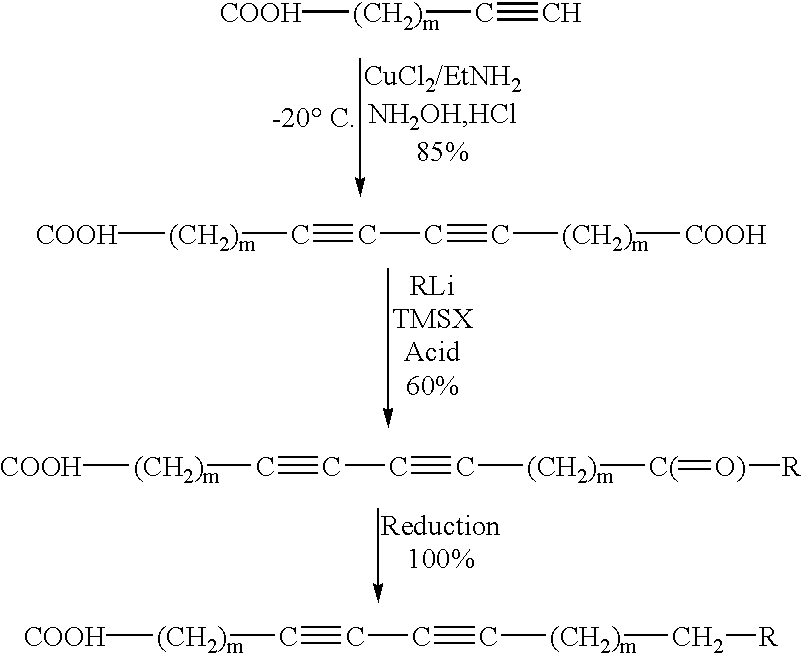Diacetylenics containing adjacent triple bonds
a technology of diacetylenic acid and triple bond, which is applied in the field of preparation of diacetylenics, can solve the problems of high cost of phospholipids, less attractive in the development of technologies such as electronic devices, drug delivery systems, etc., and achieve the effect of minimizing the use of hazardous chemicals and being more cost-effectiv
- Summary
- Abstract
- Description
- Claims
- Application Information
AI Technical Summary
Benefits of technology
Problems solved by technology
Method used
Image
Examples
example 2
Synthesis of Docosa-10,12-diyn-1,20-dicarboxylic Acid
Accelerating the Rate of Reaction
COOH--(CH.sub.2).sub.8 --C.ident.CH.fwdarw.COOH--(CH.sub.2).sub.8 --C.ident.C--C.ident.C--(CH.sub.2).sub.8 --COOH
This procedure is similar to that reported in previous example except that the reaction was carried out at 35.degree. C. and air was bubbled through the reaction mixture to accelerate the coupling reaction.
A 3.64 g. (20 mmol) undecynoic acid was dissolved in aqueous potassium hydroxide solution prepared by dissolving 2.2 g KOH in 15 mL water. To the stirred, foamy solution 0.247 g (20 mmol) cuprous chloride dissolved in 10 mL 70% ethylamine was added rapidly and the reaction was stirred efficiently. The reaction initiated very rapidly as indicated by the production of yellow color soon after mixing and the development of blue color in first few minutes. A few drops of 10% hydroxylamine hydrochloride were added to make the solution yellow, i.e., to convert cupric chloride to cuprous chlor...
example 3
Synthesis of 22-Oxotricosa-10, 12-diynoic Acid
Diacetylenic keto acid was prepared by selectively reacting 1.5M methyl lithium in diethyl ether with docosa- 10,12diyn- 1,20-dioic acid at ice-water temperature. The reaction of MeLi with 22-oxotricosa-10, 12-diynoic acid, i.e., HOOC(CH.sub.2).sub.8 C.ident.C--C.ident.C(CH.sub.2).sub.8 COOH, in ether was probed for its completion by taking a small aliquot, work up, and recording an NMR spectrum. Presence of starting material indicated that reaction didn't go through. This was due to partial insolubility of diacetylenic diacid in ether and more insolubility of Li carboxylate. Therefore, a small amount of the THF was added to make the diacid go into solution. ##STR6##
In this reaction, four to six mole equivalents of methyl lithium were used. Addition of first two moles produced thick white suspension and the third mole actually reacted with carboxylic oxygen and fourth mole was kept as an excess to let the reaction proceed further. The la...
example 4
Reaction of HOOC--(CH.sub.2).sub.8 --C.ident.C--C.ident.C--(CH.sub.2).sub.8 --COOH with Methyl Lithium
290 mg (0.8 mmol) of the dicarboxylic acid dissolved in 10 ml of tetrahydrofuran (THF) and 8 mL ether was reacted with 4.8 mmol (3.4 mL of 1.4 Molar solution) of methyl lithium (actual 6.72 mmol, 4.8 mL). At the end of addition, reaction mixture turned dark brown. After 2 hours, 0.5 mL trimethylsilyl chloride (2.68 mmol, 290 mg) was added which produced red turbid reaction mixture. Finally, the reaction was quenched with 10% aqueous sulfuric acid. Work up of the reaction provided 269 mg product, for a yield of 93 %. NMR spectrum indicated the absence of side product normally produced by addition of alkyl group from lithium reagent during hydrolysis.
PUM
| Property | Measurement | Unit |
|---|---|---|
| Time | aaaaa | aaaaa |
| Time | aaaaa | aaaaa |
| Time | aaaaa | aaaaa |
Abstract
Description
Claims
Application Information
 Login to View More
Login to View More - R&D
- Intellectual Property
- Life Sciences
- Materials
- Tech Scout
- Unparalleled Data Quality
- Higher Quality Content
- 60% Fewer Hallucinations
Browse by: Latest US Patents, China's latest patents, Technical Efficacy Thesaurus, Application Domain, Technology Topic, Popular Technical Reports.
© 2025 PatSnap. All rights reserved.Legal|Privacy policy|Modern Slavery Act Transparency Statement|Sitemap|About US| Contact US: help@patsnap.com



